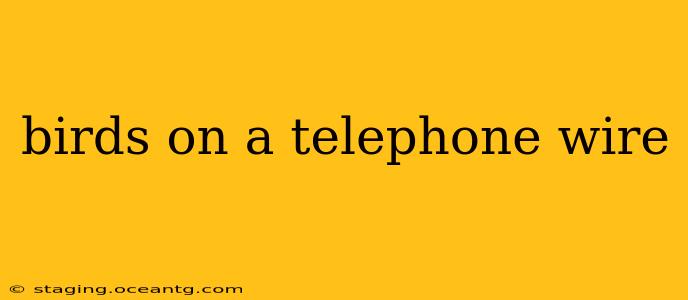Have you ever looked up and seen a line of birds perched on a telephone wire, seemingly effortlessly balanced? This common sight sparks curiosity, prompting questions about their behavior, the physics involved, and the potential dangers. This article delves into the fascinating world of birds perched on wires, answering many frequently asked questions.
Why Do Birds Perch on Wires?
Birds choose telephone wires as perching spots for several reasons. Primarily, it's about ideal vantage points. Wires offer unobstructed views of their surroundings, allowing them to scan for predators and potential food sources. The elevated position also provides a safe distance from ground-based predators. The wires themselves provide a relatively stable and easy-to-access resting spot, requiring minimal energy expenditure.
What Keeps Birds from Getting Electrocuted?
This is a common concern, and the short answer is insulation. While the electricity flows through the wire itself, the birds are insulated by their feet. They aren't making a complete circuit to the ground. However, it's important to note that this is not a foolproof system. Larger birds with a wider wingspan might touch two wires simultaneously, completing the circuit and risking electrocution. This is more likely with older, less well-maintained wires with less robust insulation.
Are Birds More Likely to Get Electrocuted on Wet Wires?
Yes, wet wires increase the risk of electrocution. Water is a conductor of electricity, so wet conditions can reduce the insulation provided by the bird's feet and increase the chance of a fatal electric shock if the bird touches multiple wires.
Why Do Birds Often Perch in a Line on a Wire?
Birds often line up on wires for several reasons, all related to safety and energy conservation. Firstly, it's a social behavior. Birds might be part of a flock and find safety in numbers. Secondly, it is more energy-efficient. Birds can minimize the energy used to stay balanced, as a slight shift in weight is compensated for by neighboring birds' weight distribution.
What Types of Birds Perch on Wires?
Almost any bird species could be found perched on wires, though you might observe some species more frequently than others. Small passerine birds like sparrows, starlings, and robins are commonly seen, due to their smaller size and lighter weight. Larger birds like crows and ravens also use wires, but their larger size necessitates finding a thicker, more robust wire to support their weight safely.
Do Birds Feel the Electricity?
While birds don't typically feel an electric shock when perching on a single wire, they likely perceive some subtle electric fields. The extent to which they "feel" this is unknown, but it is possible that they have some level of awareness of the presence of electricity. The perception may not be like the painful shock humans experience, but rather a faint tingling or discomfort.
Are Birds at Risk on Power Lines?
While the risk of electrocution is relatively low for many birds in ideal conditions, several factors can increase the risk. As mentioned earlier, larger birds, wet wires, and poorly maintained lines are all contributing factors. Also, younger or inexperienced birds are more likely to make mistakes and potentially touch multiple wires. The design of power lines themselves also plays a role. Modern, well-maintained lines typically incorporate features to reduce the risk to birds.
In conclusion, while the sight of birds perched on telephone wires is a commonplace occurrence, it highlights the intricate balance between avian behavior, physics, and environmental factors. Understanding this fascinating phenomenon helps us appreciate the adaptability of birds and the importance of responsible power line maintenance.
